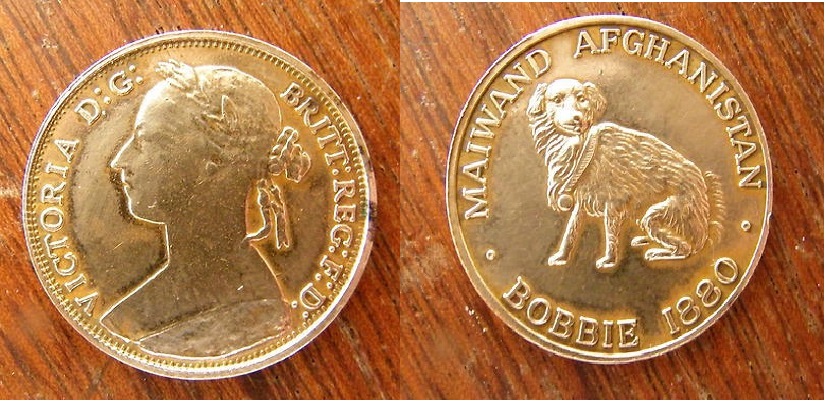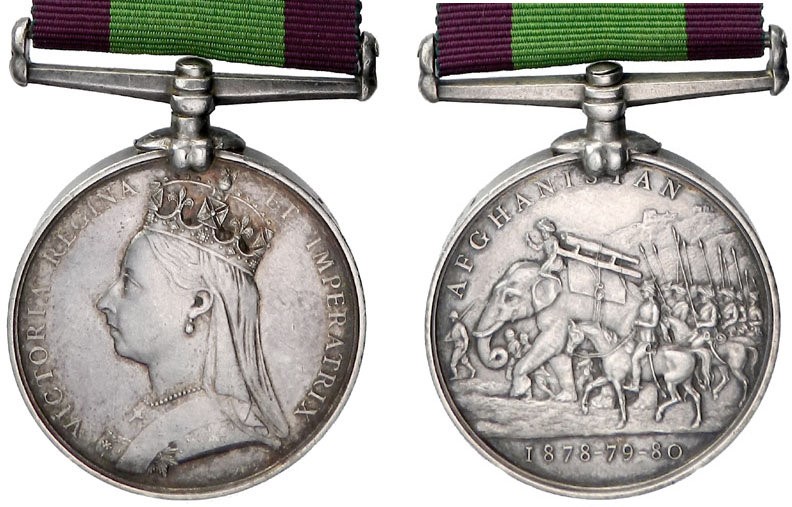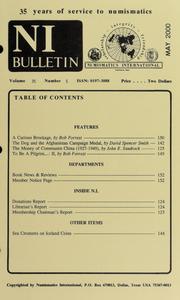A Scion Society of The Baker Street Irregulars

The Dog and the Afghanistan Campaign Medal (2000)
A recent NI BULLETIN article (Smith, 1998) considered the copper fulus produced during the British occupation of the city of Qandahar during the Second Afghan War, and an unusual footnote is now added. It was mentioned that in the final phase of the war, on 27th July 1880, Ayub Khan “…defeated a sizeable British force from Qandahar at Maiwand, and besieged the city”. Ayub Khan was a son of Sher Ali, a former ruler of Afghanistan; in September 1879 he was responsible for the massacre of the British envoy and staff in Kabul and was, in effect, a war-lord operating outside central governmental control. Seven weeks after Maiwand, his forces were routed at the battle of Qandahar [often written as Kandahar or Candahar in British texts] by a force commanded by General Roberts, who in twenty days had marched over 300 miles from Kabul with his army of British, Gurkha and Indian troops. While this battle on 1st September ended the war, British occupation of the city continued until 21st April 1881; Qandahar was then handed over to Abdur Rahman, the new ruler of Afghanistan.
Even the names of many battles fought on distant campaigns during the last century and earlier fade, except in the collective memory of the regiments who fought them. After publication of the article on the Qandahar fulus, the author chanced to visit the Royal Gloucestershire, Berkshire and Wiltshire Regiment Museum in Salisbury, England, where the battle of Maiwand is vividly recalled, since it was the 66th (Berkshire) Regiment that was almost destroyed on that day. The Museum offers a penny-size medallet (Fig. 1) bearing on the obverse the appropriate “Mature bust” of Victoria and inscription as on the British penny (KM-754), and on the reverse a dog, with the inscription “Maiwand Afghanistan. Bobbie 1880”. The museum’s exhibit described how this dog came to be presented to Queen Victoria with the Afghanistan 1878-1880 Campaign Medal. The following brief details of the circumstances of the unique presentation are taken from the exhibit, with notes on the battle from the official regimental history (Petre, 1925).

Fig. 1
In brief, the small rough-haired terrier was the mascot of the 66th (Berkshire) Regiment, in the care of Sgt P. Kelly. The regiment left Qandahar, moving west to cover the Helmand river, to block Ayub Khan’s approach to the city and, near the village of Maiwand on 27th July, they were attacked from the hills by Ayub’s troops who outnumbered them at least ten-to-one, augmented by an even larger number of tribal irregulars. Initially, the Afghans suffered heavy losses, but the British lines became confused and the troops fell back in three groups. One group, of about 100 officers and men all died, making repeated stands until the last, when only eleven remained. The 66th (Berkshire) Regiment had 19 officers and 497 other ranks taking part in the battle; of these ten officers and 275 other ranks died and 32 were wounded. The regimental history records details of the thirty-three hour fighting retreat of survivors along the 50 hostile and waterless miles back to Qandahar, and the further losses suffered en route. The museum exhibit describes how the dog returned alone from Maiwand to Qandahar “bedraggled, dirty and covered in blood” with a bullet injury. After Ayub Khan’s defeat, the 66th (Berkshire) Regiment returned to England via Karachi and Bombay, reaching Portsmouth in February 1881. Later that year the Regiment, with the now recovered Bobbie, visited the Isle of Wight to be received by Queen Victoria. At Osborne House the Queen “was greatly moved by the story of his devotion and… presented Bobbie with the Afghan medal, tying it herself to his collar with its ribbon of green and red”.
The regimental history records that the London Gazette of 7th June 1881 announced that:
“The Queen has been graciously pleased to permit the following Regiments to bear the words specified below upon their standards, Colours and appointments respectively in commemoration of their gallant behaviour during the recent campaigns in Afghanistan. . .66th (Berkshire) Regiment
“Kandahar 1880”
“Afghanistan 1879-80”
The silver Afghanistan 1878-79-80 Campaign Medal is shown in Fig. 2

Fig. 2
A century ago, the battle of Maiwand was fresh in British memory. A painting that included the regimental mascot in the “Stand of the Last Eleven” by Frank Feller was exhibited in the National Gallery, and the display notes that, in introducing Dr. Watson to his public, Conan Doyle (1887) recorded in “Study in Scarlet” the doctor’s attachment to the 66th (Berkshire) Regiment and the severe injury he sustained at the battle of Maiwand, before his association with Sherlock Holmes began. The museum display notes the similarity between this injury and that suffered at Maiwand by Surgeon-Major A. F. Preston, as recorded in the regimental history.
At first sight, it might seem odd to commemorate a disaster in battle with a medallet for the surviving mascot. Yet it seems to the author an effective reminder of an event that took place over a century ago; a battle that although costly, led swiftly to Ayub Khan’s defeat and the end of the Second Afghan War, introducing years of stability in the region.
The author is grateful to Lt Col David Chilton, the museum’s Manager and Curator, for approving use of material in the Maiwand display and for making available details from the regimental history. Information on the museum may be obtained from: The Wardrobe, 58 The Close, Salisbury, Wiltshire SP1 2EX, UK, or the Internet: < www.thewardrobe.org.uk >
References:
Conan Doyle, A. (1887) A Study in Scarlet. London.
Petre, F. L. (1925) The Royal Berkshire Regiment (Prince Charlotte of Wales’), 1, (1743-1914), Reading, pp. 281-297.
Smith, D. S. (1998) “A British Crown on an Afghan Coin”. NI BULLETIN, 33, 209-212 .
 David Spencer Smith, MA, Ph. D. (1930 – 2005), was the Hope Professor of Zoology and Entomology at the University of Oxford from 1980 – 1995, and later an Emeritus Fellow of the College and was also associated with the Oxford University Museum. He was the author of The Butterflies of the West Indies and South Florida and was life member 92 of Numismatics International.
David Spencer Smith, MA, Ph. D. (1930 – 2005), was the Hope Professor of Zoology and Entomology at the University of Oxford from 1980 – 1995, and later an Emeritus Fellow of the College and was also associated with the Oxford University Museum. He was the author of The Butterflies of the West Indies and South Florida and was life member 92 of Numismatics International.
This article was originally published in the May 2000 issue of the NI Bulletin (Volume 35, Number 5) and is reprinted here with the permission of Numismatics International and the author’s family.
The original article, as well as the complete issue of this NI Bulletin, can be viewed at the Newman Numismatic Portal.
